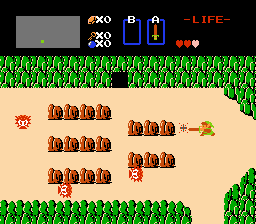Link (The Legend of Zelda) facts for kids
Quick facts for kids Link |
|
|---|---|
| The Legend of Zelda character | |
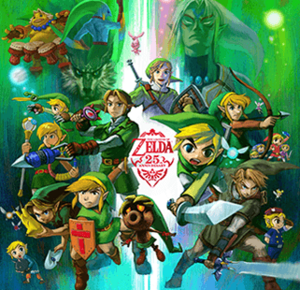
Various incarnations of Link, as seen in The Legend of Zelda: Hyrule Historia
|
|
| First appearance | The Legend of Zelda (1986) |
| Created by | Shigeru Miyamoto |
| Voiced by |
|
| Information | |
| Race | Hylian |
| Gender | Male |
| Occupation |
|
| Origin | Hyrule |
| Weapon | Master Sword |
Link is the main hero of Nintendo's famous video game series, The Legend of Zelda. He was created by the Japanese game designer Shigeru Miyamoto. Link first appeared in the original The Legend of Zelda game in 1986. Since then, he has been in many games in the series, plus spin-offs.
In the games, Link often travels through the land of Hyrule. He explores tricky dungeons, battles scary creatures, and solves puzzles. His main goal is usually to defeat the evil Ganon and save Princess Zelda.
Link has appeared in many different forms throughout the series. He is usually shown wearing his green cap and tunic, carrying a sword and shield. He can be a child or a young adult, and he belongs to the Hylian race, which looks like elves. In the Zelda stories, Link is the spirit of a legendary hero. This spirit is reborn into a seemingly ordinary boy or young man whenever evil threatens Hyrule. To defeat Ganon, Link often finds the magical Master Sword or another powerful weapon after completing many challenges.
Besides the main games, Link has also appeared in other Nintendo products. These include toys, comics and manga, and an animated television series. He is also a key character in spin-off games like Hyrule Warriors and Cadence of Hyrule. Link has even shown up in other game series, such as Super Smash Bros. and Mario Kart 8. He has also been mentioned in games like The Elder Scrolls V: Skyrim.
Link is one of the most recognizable characters in video games, alongside Mario. He helped shape the role-playing video game genre. The Zelda series, with Link as its hero, influenced many other games with its ideas of open world and nonlinear gameplay. According to Guinness World Records, Link is one of the most praised video game characters. He is also considered one of the greatest and most influential video game characters ever.
Contents
How Link Was Created
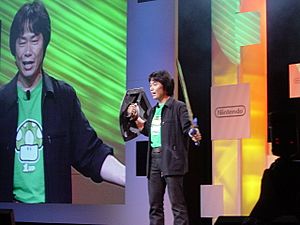
Link's creator, Shigeru Miyamoto, based The Legend of Zelda on his childhood memories. He also took ideas from books and movies he enjoyed, like J. R. R. Tolkien's The Lord of the Rings. Miyamoto wanted players to feel like heroes. So, he made Link a normal boy with "a destiny to fight great evil."
Miyamoto explained how Link got his name. He said that originally, parts of the Triforce were supposed to be electronic chips. The game would take place in both the past and the future. Link would travel between these times, being the "link" between them. In the book Hyrule Historia, Miyamoto also said Link "connects people together."
Link is the character you play as in every The Legend of Zelda game. Even though there are many versions of Link, they are not always the same person. The series covers thousands of years in Hyrule's history. This means each Link is a different hero, sometimes a descendant or a reborn spirit of earlier Links. In some games, like Ocarina of Time and Majora's Mask, the same Link appears. This continues that character's personal story.
Skyward Sword (2011) explained why Link keeps appearing. It showed an origin story where the bad guy, Demise, curses the hero. This curse means the hero will always be caught in a cycle of fighting evil, usually Ganon.
Link usually doesn't speak much in the games. He is a silent protagonist. His voice acting is mostly grunts and battle cries. However, in The Wind Waker, he can be heard saying, "Come on!" Even without talking, Link shows his feelings through actions like nodding or shaking his head. Other characters' reactions or game text also show what he's saying. The series producer, Eiji Aonuma, explained that Link is silent so players can imagine themselves as the hero. This helps players feel more connected to Link.
Link's Look Over Time
Link's design has changed over the years, but it has stayed mostly consistent. His first look was created by Takashi Tezuka. Miyamoto said that Tezuka was inspired by Disney's Peter Pan to make Link easy to recognize. In the first game, they could only use three colors. They chose green for Link because the game was set mostly in a forest. Link's sword, shield, long hat, and pointy ears were all added to make him stand out.
For Ocarina of Time, the team first designed an adult Link, then a child Link. They realized they could use both in the game to tell a story about a boy growing up. Link's teenage look in Ocarina of Time was made to be more handsome. This was influenced by a developer's wife who said Nintendo characters had "funny noses."
Before The Wind Waker, a cartoon version of Link was created. This new style was well-liked by the game's team. Designer Satoru Takizawa said this cartoon-like design, with big eyes, allowed for more expressions. It also helped show puzzles better than a realistic design. The team decided that cel-shading was best for showing a young, energetic boy. The team loved the cartoon Link idea, but Miyamoto was worried it wouldn't sell. However, the team insisted there wasn't enough time for a realistic style. This cartoon Link, often called Toon Link, became popular. He appeared in many games and even became a playable character in Super Smash Bros.
After The Wind Waker, Nintendo changed Link's art style for Twilight Princess (2006). This game showed Link in a more realistic and darker style. The designers had planned to make him in his mid-to-late twenties and muscular. But this idea was rejected because fans wanted Link to look like he did in Ocarina of Time. Aonuma explained that they wanted Link to look like an older teenager. In Twilight Princess, Link can also turn into a wolf. Aonuma said the wolf was chosen as the best animal to represent a hero. This ability helped the adult Link grow during the game.
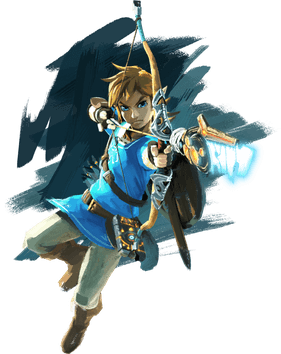
Link's famous green tunic and cap have changed over the series. For Twilight Princess, the hat was made long so it would flap in the wind. For Skyward Sword, it was made smaller. The release of Breath of the Wild in 2017 broke Link's traditional design. His green outfit was gone. Takizawa explained that with better graphics, it was harder to make the hat look cool. For Breath of the Wild, almost 100 designs were considered to keep Link a neutral character. Aonuma said no one on the team said, "Let's make him blue!" It just happened naturally.
Link's physical features have also changed, influenced by fashion trends. His handsome look often includes soft, androgynous (looking both male and female) facial features, a sharp nose, and a slim build. His hair has followed fashion, from a mullet in the 1980s to blond bangs in the 1990s. In Breath of the Wild, he got a ponytail and many different outfits.
Even though Link is a male character, Aonuma wanted him to be gender neutral in Ocarina of Time. He wanted players to think, "Maybe Link is a boy or a girl." For Twilight Princess, he made Link more masculine. But later, he decided to make Link more gender neutral again. He confirmed Link is male in Breath of the Wild, but still wanted to create a character anyone could relate to.
His Voice Actors
Link has been voiced by several actors in the games and other shows. Nobuyuki Hiyama voiced adult Link in Ocarina of Time and other games. Fujiko Takimoto voiced young Link in Ocarina of Time and other titles. Sachi Matsumoto voiced Toon Link in games like The Wind Waker. Akira Sasanuma voiced Link in Twilight Princess. Yūki Kodaira voiced him in Spirit Tracks. Takashi Ōhara voiced Link in Skyward Sword. Mitsuki Saiga voiced him in A Link Between Worlds. Kengo Takanashi voices Link in newer games like Breath of the Wild and Tears of the Kingdom.
In spin-off games, Yuki Kaji voiced Link in Hyrule Warriors. Caitlyn Bairstow voiced him in Cadence of Hyrule. For the CD-i games, Jeffrey Rath was Link's voice. In the animated TV series, Jonathan Potts voiced Link.
Link's Characteristics
Link is known as the "Hero of Hyrule." He is the main hero of The Legend of Zelda series. Whenever a great evil threatens the Kingdom of Hyrule, usually Ganon, Link is the one chosen to fight it. He is destined to bring peace back to Hyrule. He often starts each game as a child or young adult who might seem a bit lazy or unprepared. But he grows his skills and experience as the game goes on.
His story changes from game to game, but it usually involves solving dungeon puzzles, saving Princess Zelda, and defeating Ganon or another villain. Link has the features of the Hylian race, looking human-like with pointy, elfin ears. Since the first game, he has often worn his green cap and tunic and carries a sword and shield. Link's age changes across the series. He was ten in the first game and sixteen in its sequel. In Ocarina of Time, he starts at nine and becomes sixteen after a time jump. In The Wind Waker, Toon Link is twelve. In Twilight Princess, Skyward Sword, and Breath of the Wild, Link is usually sixteen or seventeen.
In the stories of the series, Link is the reborn soul of a hero. He is chosen by the goddess Hylia to protect Hyrule and save Princess Zelda whenever needed. He also carries the Triforce of Courage. This is one of the three parts of the Triforce, a sacred symbol of power. The Triforce of Courage represents Link's bravery and the player's curiosity to explore. In many Zelda games, Link's main goal is to find the pieces of the Triforce to defeat Ganon.
Link can use many weapons, like bows, boomerangs, and magic rods. But his most famous weapon is the Master Sword. This is a powerful magic sword that can defeat evil. Throughout each game, Link finds various items that help him. Many of these items have magical powers, like a magic cape that makes him invisible. Others have practical uses, like the hookshot, which pulls items towards him, or bombs to blow up walls. Link has also used many musical instruments, especially the Ocarina of Time, which he uses to teleport.
In Breath of the Wild, Link's main tool is the Sheikah Slate. This is a tablet with special powers that let him change the game world. A similar device, the Purah Pad, gives Link many functions in Tears of the Kingdom, like a camera, map, and telescope.
Link's Relationships
Link's relationships with the other two main characters are very important to the series. Ganon, Zelda, and Link represent the three parts of the Triforce. Ganon stands for Power, Zelda for Wisdom, and Link for Courage. This trio means the three characters are reborn repeatedly in an endless battle between good and evil.
The exact nature of Zelda and Link's relationship is often unclear. A romantic connection was strongly hinted at in a trailer for Skyward Sword. Aonuma said they wanted players to feel that Zelda was very important to Link. They used hints of romance to make players care about finding her.
Link's Game Appearances
Here's a look at Link's appearances in the The Legend of Zelda series and other games.
In The Legend of Zelda Series
Link first appeared on the Nintendo Entertainment System (NES) in The Legend of Zelda (1986). He was an 8-bit 2D character seen from above. He looked short and stubby with brown hair, wearing a green cap and tunic. In the game, he gets a sword from an old man who says, "It's dangerous to go alone!" Link must save Princess Zelda and Hyrule from the evil wizard Ganon. He explores many areas and dungeons, collecting items to defeat bosses before facing Ganon.
In Zelda II: The Adventure of Link (1987), Link was a bit taller and still wore a green outfit. His shield had a cross, but this was removed in later games. The game switched between exploring from above and side-scrolling action. Link could stab up and down with his sword while jumping. He gained Experience points to improve his health and attack power. He also learned magic spells for special abilities. To finish the game, Link had to defeat his evil copy, Dark Link, to wake up a sleeping Zelda.
A Link to the Past (1991) on the Super Nintendo Entertainment System gave Link a 16-bit colorful look. He had unusual pink hair in the game, though art showed him with blond hair. Link's movements became more detailed. He could move diagonally, swing his sword in an arc, and do a spin attack. The game brought back the top-down view and introduced items like the hookshot and the Master Sword. His health was now shown in "heart pieces" that players had to find.
The first handheld game, Link's Awakening (1993) on the Game Boy, showed Link in monochrome (black and white). A later version for the Game Boy Color added color. Link washes ashore on Koholint Island. This game mixed top-down adventure with some side-scrolling parts. It was the first overhead game where Link could jump. The game's cutscenes showed Link in an anime art style. The goal was to collect eight musical instruments to wake the Wind Fish.
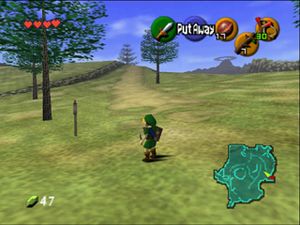
Ocarina of Time (1998) for the Nintendo 64 (N64) was the first 3D Zelda game. Link had blonde hair, and his horse Epona was introduced. The story allowed players to control Link as both a child and a young adult. His green outfit showed his role as a Kokiri. His shield now had the Hyrule crest. Link could do many new movements like swiping, stabbing, rolling, dodging, and diving. The game's Z-targeting system let him lock onto enemies. He could also automatically jump from ledges. A fairy named Navi helped him by giving hints.
Link returned on the N64 in Majora's Mask (2000). As a child again, he had to save Termina from the evil Majora's Mask. The moon was falling, threatening to crash in three days. Link used the Ocarina of Time to play the Song of Time, letting him go back in time repeatedly to stop the disaster. He found magical masks that turned him into a Goron, Deku Scrub, or Zora, each with special powers. In the final battle, Link became Fierce Deity Link, a powerful adult version of himself.
In Oracle of Seasons and Oracle of Ages (2001) for the Game Boy Color, Link was controlled from a top-down view in a 2D world. These two connected games sent Link to Holodrum and Labrynna. He had to stop Onox from messing with the seasons and Veran from messing with time. Link used the Rod of Seasons and a magic harp to explore and fight.
A Link to the Past & Four Swords (2002) for the Game Boy Advance included a new game, Four Swords. This game was different because it focused on cooperative gameplay. Four players could connect their Game Boy Advance systems and play together. In Four Swords, four Links of different colors appeared, each controlled by a different player. They had to work together to complete challenges.
The Wind Waker (2002) for the GameCube showed Link and the world in a cute, cartoon-like style. Link was a preteen cartoon character with a big head and huge eyes. His facial expressions showed many emotions. The game involved exploring islands, finding characters, and clearing dungeons. Link's main tool was the Wind Waker, a magical baton that let him control the wind to sail the Great Sea.
Four Swords Adventures (2004) for the GameCube also focused on multiplayer. Link was split into four versions of himself by the Four Sword. These four Links, each a different color, had to work together to rescue seven princesses. The game showed the Links from a 16-bit top-down view. Each player controlled one Link to explore and fight enemies.
The Minish Cap (2004) for the Game Boy Advance returned to a single-player format. Link appeared as a child from a top-down view, tasked with saving Princess Zelda. A mysterious stranger broke a sacred sword and turned Zelda to stone. Link was joined by a talking magical cap named Ezlo. Ezlo helped him and taught him to shrink to the size of the Minish.
Twilight Princess (2006) for the GameCube and Wii offered a darker adventure. It showed a more detailed teenage Link, ready for battle with chainmail under his tunic. Early in the game, he was trapped in the Twilight and turned into a wolf. An imp-like creature named Midna helped him. The game used animal abilities, like following scents, to progress. Twilight Princess aimed to be a strong contrast to The Wind Waker's cartoon style, with a darker look and story.
A direct sequel to The Wind Waker, Phantom Hourglass (2007) for the Nintendo DS, followed Link as he saved his friend Tetra. The game used 3D cel-shaded graphics and a light-hearted tone, similar to The Wind Waker. Toon Link showed many funny expressions. The game used the console's touchscreen, letting players control Link with a stylus instead of buttons.
Spirit Tracks (2009) also for the Nintendo DS, brought back Toon Link. It was a sequel to Phantom Hourglass but replaced sailing with train travel. Link had to explore four map areas, restore power to the spirit tracks with the Spirit Flute, and navigate the Spirit Tower. The game also let players control both Link and Zelda together to solve puzzles and fight bosses.
Skyward Sword (2011) for the Wii used Wii MotionPlus for sword swipes and controlling a mechanical beetle. Link could also ride his loftwing through the skies. The story included a romantic relationship between Link and Zelda. Starting in Skyloft, a land above the clouds, Link had to go to the surface after Zelda was kidnapped. He traveled between lands with the Goddess Sword, which held a spirit named Fi who guided him. Link later turned the Goddess Sword into the Master Sword. The game added a stamina meter for climbing and sprinting, and the ability to craft new items.
A Link Between Worlds (2013) for the Nintendo 3DS was a sequel to A Link to the Past. The story was about a sorcerer named Yuga who could merge into walls and turn people into paintings. Link had to stop his plan to bring back Ganon. The game was set in the same world as A Link to the Past and had a similar art style. Players could explore two separate worlds, Hyrule and Lorule. A new ability let Link turn into a painting, allowing him to walk along walls and switch between worlds.
Tri Force Heroes (2015) was another Zelda game for the Nintendo 3DS. It was different because it focused on three-player cooperative gameplay. Link appeared with two friends who could stack on top of each other to reach high places and solve puzzles. The story was about fashion in Hytopia, where a witch cursed Princess Styla. The king called for heroes to break the curse. The game had dungeons and collecting materials to make outfits with special abilities.
Breath of the Wild (2017) for the Nintendo Switch and Wii U changed the series by creating a huge open world for Link to explore. He could climb most surfaces, jump from high places, and glide across the sky with a paraglider. He could interact with the environment, collect materials for cooking, and react to cold and heat. His design changed significantly, with his green outfit being absent. Players could dress Link in many different outfits. The bow became a more important weapon.
Link appears in Tears of the Kingdom (2023), a direct sequel to Breath of the Wild. It is set in the same Hyrule. Link loses his right arm after an attack and is saved by the spirit Rauru, who gives Link his own arm. This new arm is important for Link's abilities. It helps him stand out from past versions. Link's new powers include Recall (rewinding objects), Fuse (merging objects to make new weapons), Ultrahand (building vehicles), and Ascend (moving through ceilings). He also gets Autobuild, which lets him rebuild vehicles automatically.
Spin-off Games
In 1989, Link appeared in Zelda, a Game & Watch handheld electronic game. It had two screens. The bottom screen showed Link fighting monsters, and the top screen showed his inventory. The game was simpler than the NES version. Link had to defeat eight dragons to rescue Zelda. In the same year, a The Legend of Zelda Game Watch was released. It was a wristwatch with a game based on the original Zelda, but without a story.
Link also appeared in Zelda no Densetsu: Kamigami no Triforce (Barcode Battler II) in Japan in 1992. This game used cards that players swiped to unlock characters from A Link to the Past.
Link appeared in the The Legend of Zelda CD-i games: Link: The Faces of Evil, Zelda: The Wand of Gamelon, and Zelda's Adventure. These games were made by Philips, not Nintendo. They were not well-received and are not part of the official Zelda story. Unlike the main series, Link could speak in these games. His personality was similar to the animated TV series.
Nintendo released a shooting video game in 2007 called Link's Crossbow Training for the Wii. It was set in the Zelda world and featured Link with a crossbow. The game revisited places and enemies from Twilight Princess. Players used the Wii remote to aim at enemies.
In the 2014 hack and slash game Hyrule Warriors, a new version of Link appeared as a Hyrulian soldier. Young Link from Ocarina of Time and Majora's Mask was also a playable character through downloadable content. Toon Link from The Wind Waker appeared in Hyrule Warriors Legends for the Nintendo 3DS.
Link is also a playable character in Cadence of Hyrule (2019), a Nintendo Switch rhythm game. This game combines Crypt of the NecroDancer and The Legend of Zelda. Players can choose to play as Link or Zelda. Link can do a spin attack and use a shield.
In Hyrule Warriors: Age of Calamity, a prequel to Breath of the Wild, Link fights alongside many characters. The game has missions that help Link and his allies level up.
Other Game Series
Link has made cameo appearances in other SNES games. In Donkey Kong Country 2: Diddy's Kong Quest, he was ranked against the player. He also appeared sleeping in an inn in Super Mario RPG alongside Samus Aran. Link can also be found in a challenge course in F1 Race.
He is a playable character in the Super Smash Bros. series and has been in every game since the first Super Smash Bros. on the Nintendo 64. In 2008, Toon Link from The Wind Waker appeared in Super Smash Bros. Brawl on the Wii. Link later returned in Super Smash Bros. Ultimate for the Nintendo Switch in different forms. These included green tunic Link, blue tunic Link from Breath of the Wild, Toon Link, and Young Link.
In the GameCube version of Namco's Soulcalibur II, Link was a special guest character. Miyamoto was fine with Link being in a fighting game because he had already fought in Super Smash Bros.. Link was also featured in a Zelda-themed game mode in the puzzle game Tetris DS (2006). In Scribblenauts Unlimited, many Zelda characters, including Link, can be summoned in the Wii U version. He is referenced by an archer in green in The Legend of Zelda: Battle Quest, a mini-game in Nintendo Land (2012). Link's costume appeared in Dynasty Warriors VS for the Nintendo 3DS. Link appeared in Sonic Lost World as part of "The Legend of Zelda Zone." In NES Remix (2013), players could play as Link in a level of Donkey Kong.
The Skyward Sword version of Link was a playable character in Mario Kart 8, riding a motorcycle. In Mario Kart 8 Deluxe, his Breath of the Wild version also appeared. Link is referenced in downloadable content for Monster Hunter 4 (2015) with armor like his tunic. Different versions of Link also appeared as "Mystery Mushroom" costumes in Super Mario Maker. In 2016, Link appeared in a 3DS puzzle game called My Nintendo Picross - The Legend of Zelda: Twilight Princess. The Master Sword and Hylian Shield, along with Link's Champion's Tunic from Breath of the Wild, appear as unlockable content in the Nintendo Switch version of The Elder Scrolls V: Skyrim. In 2019, Link was added as a playable character in Super Mario Maker 2. The Master Sword power-up changes Mario characters into Link.
Television Series
From 1989 to 1990, The Legend of Zelda animated series aired. Thirteen episodes were made. Loosely based on the first game, the series showed Link as a rude, lovesick teenager. He lived in Hyrule Castle and protected the Triforce of Wisdom from Ganon, helped by a fairy princess named Spryte. He often tried to kiss Zelda and would say, "Well excuse me, Princess!" when annoyed. This phrase became a famous in-joke among gamers.
A similar version of Link and Zelda appeared in the second season of Captain N: The Game Master. The story involved a character named Kevin entering a game world. He helped Link and Zelda stop Ganon from returning.
In 2013 and 2014, Link appeared in short funny videos called The Legend of Zelda: The Misadventures of Link. These videos were based on The Wind Waker HD and aimed to show Link in a "new and hysterical light."
Comics and Manga
After the first game, a manga book called "The Hyrule Fantasy" was released in Japan in 1986. It followed the game's plot with some additions, like Link and Zelda talking telepathically. Link appeared in manga-style novels published by Futabasha, including The Legend of Zelda: The Mirage Castle (1986). A similar book, The Legend of Zelda: The Triforce of the Gods (1992), was based on A Link to the Past.
In the early 1990s, Valiant Comics published a comic series based on The Legend of Zelda. It lasted for five issues. In this comic, Link had red hair instead of his usual blonde or brown. The story was similar to The Legend of Zelda animated TV series. Link and Zelda's relationship was shown as romantic.
A manga version of A Link to the Past was created by Ataru Cagiva in 1995. A comic series was also made for Nintendo Power magazine by Japanese manga artist Shotaro Ishinomori. It was published in 1992 and later collected into a graphic novel. The story was a different version of A Link to the Past. Several other manga versions based on Zelda video games have been published by Viz Media. These include Ocarina of Time, Majora's Mask, and The Minish Cap, illustrated by Akira Himekawa. The Japanese artist duo also wrote the long-running Twilight Princess manga. Nintendo also published Link's Hijinks, a translated web comic by Saitaro Komatsu.
Gamebooks
Nintendo published several gamebooks based on The Legend of Zelda. As part of the Nintendo Adventure Book series, two books were released in 1992: The Crystal Trap and The Shadow Prince. In The Crystal Trap, Zelda saved Link. In The Shadow Prince, Link saved Zelda with help from a character named Charles. In 2001, two books based on Oracle of Seasons and Oracle of Ages were published by Scholastic. These books, written by Craig Wessel, featured Link in stories based on the video games.
Merchandise
Since 2014, many amiibo figures of Link have been released. Three amiibo for the Super Smash Bros. series (Link, Toon Link, and Young Link) were released between 2014 and 2019. Various Zelda series amiibo have also been created. These include Wolf Link and Midna, 8-bit Link, Ocarina of Time Link, Toon Link from The Wind Waker, and versions from Majora's Mask, Skyward Sword, Twilight Princess, and Link's Awakening. There are also archer and rider figures from Breath of the Wild, and the version from Tears of the Kingdom. Guinness World Records reported that Link was the Nintendo character with the most amiibo figures as of February 1, 2018. Besides appearing on branded items, Link's image has been used for figurines, plush toys, and action figures.
See also
 In Spanish: Link (personaje) para niños
In Spanish: Link (personaje) para niños


